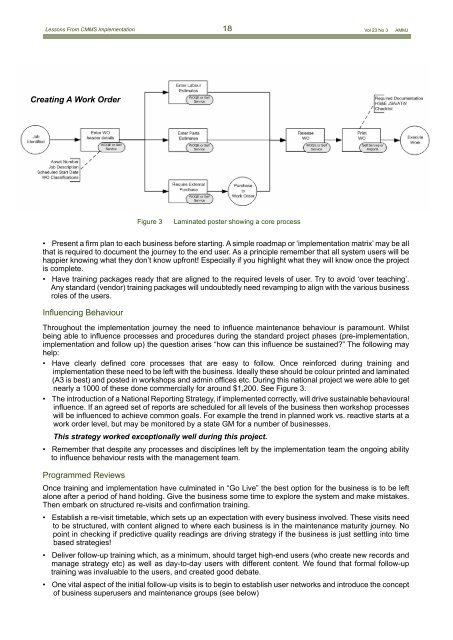SKF Reliability Systems - Library
SKF Reliability Systems - Library
SKF Reliability Systems - Library
You also want an ePaper? Increase the reach of your titles
YUMPU automatically turns print PDFs into web optimized ePapers that Google loves.
Lessons From CMMS Implementation<br />
Creating A Work Order<br />
• Present a firm plan to each business before starting. A simple roadmap or ‘implementation matrix’ may be all<br />
that is required to document the journey to the end user. As a principle remember that all system users will be<br />
happier knowing what they don’t know upfront! Especially if you highlight what they will know once the project<br />
is complete.<br />
• Have training packages ready that are aligned to the required levels of user. Try to avoid ‘over teaching’.<br />
Any standard (vendor) training packages will undoubtedly need revamping to align with the various business<br />
roles of the users.<br />
Influencing Behaviour<br />
Figure 3 Laminated poster showing a core process<br />
18 Vol 23 No 3 AMMJ<br />
Throughout the implementation journey the need to influence maintenance behaviour is paramount. Whilst<br />
being able to influence processes and procedures during the standard project phases (pre-implementation,<br />
implementation and follow up) the question arises “how can this influence be sustained?” The following may<br />
help:<br />
• Have clearly defined core processes that are easy to follow. Once reinforced during training and<br />
implementation these need to be left with the business. Ideally these should be colour printed and laminated<br />
(A3 is best) and posted in workshops and admin offices etc. During this national project we were able to get<br />
nearly a 1000 of these done commercially for around $1,200. See Figure 3.<br />
• The introduction of a National Reporting Strategy, if implemented correctly, will drive sustainable behavioural<br />
influence. If an agreed set of reports are scheduled for all levels of the business then workshop processes<br />
will be influenced to achieve common goals. For example the trend in planned work vs. reactive starts at a<br />
work order level, but may be monitored by a state GM for a number of businesses.<br />
This strategy worked exceptionally well during this project.<br />
• Remember that despite any processes and disciplines left by the implementation team the ongoing ability<br />
to influence behaviour rests with the management team.<br />
Programmed Reviews<br />
Once training and implementation have culminated in “Go Live” the best option for the business is to be left<br />
alone after a period of hand holding. Give the business some time to explore the system and make mistakes.<br />
Then embark on structured re-visits and confirmation training.<br />
• Establish a re-visit timetable, which sets up an expectation with every business involved. These visits need<br />
to be structured, with content aligned to where each business is in the maintenance maturity journey. No<br />
point in checking if predictive quality readings are driving strategy if the business is just settling into time<br />
based strategies!<br />
• Deliver follow-up training which, as a minimum, should target high-end users (who create new records and<br />
manage strategy etc) as well as day-to-day users with different content. We found that formal follow-up<br />
training was invaluable to the users, and created good debate.<br />
• One vital aspect of the initial follow-up visits is to begin to establish user networks and introduce the concept<br />
of business superusers and maintenance groups (see below)

















